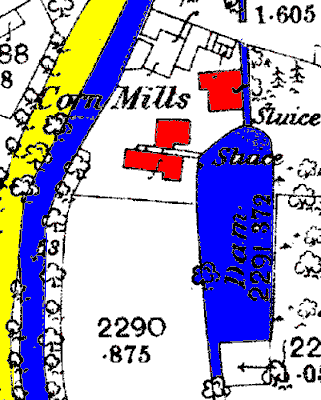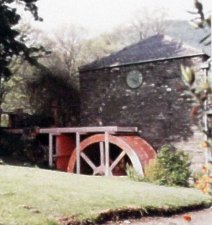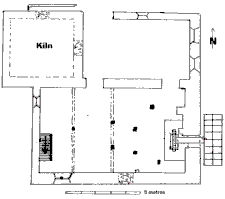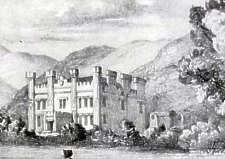(30) Milntown Mills

From 1868 O/S Plan V/10 - SC 437943
Only the most northerly building remains - one of the other mills was
a threshing mill
|

as externally restored c.2005

ground plan
Both extracted from a report by P Weatherall held in Manx Museum
|
Milntown would appear to have gained its name early in the 16th century when
the estate was developed by the powerful Christian family. The existing shell
was a working mill until the early 1950s but was in a very decayed state when
the estate was purchased in 1963 by Sir Clive Edwards and friend Bob Thomas
- both now deceased with the estate being managed by a trust established by
Sir Clive.
There are three mills included in the rental of Milntown mentioned in the 1760
updated copy of the 1704 composition book.

extracted from a c.1830 etching (included in Weatherall)
The mill can be seen behind the newly rebuilt house of 1830 -
the etching is by A F Tait and printed by A Miller who was Liverpool based and
also printed the 1829 Map of the roads.
Much of the history of the estate (and of other properties held by the powerful
Christian family) was lost by the wanton destruction by bonfire of the records
held at Milntown by Deemster John Christian's widow Sarah Christian in 1852.
It is likely that the present mill buildings date from c. 1830 when there was
significant rebuilding of the main house though as the building would appear
to have its roof level changed it may be earlier though an integral kiln would
suggest a very late 18th century date at the earliest - the kilns at other mills
were usually a considerably later addition - possibly this is the case here,
though the floor plan matches that shown in the 1868 O/S plan - possibly the
roof was raised when the kiln was added but Weatherall does not discuss the
age or possible construction sequence of the mill.
Ramsey Courier, 26th November 1915 noted the death of the then miller
We regret to announce the death of Mr Joseph Keig, miller, Milntown Mills,
which occurred on Wednesday after a brief illness . He was able to go about
his work up to Sunday, but was taken ill on Monday, and despite Dr Sugden's
efforts passed away as above stated. He was one of the oldest millers on the
Island and had witnessed during his long experience great developments in
the business. He commenced at Claddagh Mills, Sulby,
where his son is now miller, and the Keig family have been millers for generations,
his uncle and brothers following the same business. He spent thirty years
in England and America in the milling busines, and his son. Mr. J. B Keig,
of Lhen Mills has also had many years of experience
in England the States and Spain, and has held important positions. He leaves
two sons and a grandson all millers to carry on the business. He was at the
Carlane Mill prior to coming to Milntown Mill which
he has conducted for ten years very successfully. The Milntown Mill will be
carried on as usual by his eldest son, The funeral takes place at Lezayre
in Sunday.
His son would be the last miller at Milntown - his other son
J B Keig moved from the Lhen the Nunnery miill
David Jones in his 1964 survey of mills suitable
for preservation includes Milntown mill in the rejected group as too incomplete
or too decayed.
Weatherall quotes from some reminiscences by Bob Thomas about the partial restoration
of the mill - the wheel was completely derelict as the mill in its final days
had been operated by oil engines, and it had been roofless for 10 years by the
time of purchase. The wheel seen in the photo was newly built based on measurements
of the old wheel using 4.5 tons from a single 300year old elm and was turned
on by Joe Keig whose family had been the last millers at the mill, by operating
a nearly restored sluice gate obtained from Foxdale mill. Though some mill machinery
was kept much of the space was used to provide a workshop for car restoration
- the abiding passion of both Bob Thomas and Sir Clive.
The Kiln was beyond repair though it seems that the decayed structure remains
below a newly installed concrete floor - Bob Thomas's account was "Under
the floor is an inverted hollow pyramid of brick which had a floor above it
of perforated brick tiles on a metal framework (rusted beyond recall). Round
the outside of this Pyramid is a space with various openings - fire holes and
the remains of a flue." For the fire, Bob Thomas suggested wood was the
fuel, though coke and, before this was readily available from the town gas works,
peat, would generally be used on the timber-poor Island - however the brick
structure would provide a smoke free warmth needed to dry the often damp Manx
grain. Apparently the constant fires had rotted the brickwork making it unsafe
and thus the space was filled with rubble and a new concrete floor placed on
top.
Much of the internal gearing and the drives to the stones remained - Weatherall
includes several photos, which however are too poorly reproduced in the report
to make out details. Bob Thomas states there were 5 pairs of stones, each with
its allotted purpose but not all were retained. Other machinery only partially
rescued included the chain hoists.
References
P Weatherall The Mill's Tale : An Archaeological Survey of Milntown Corn
Mill 2007 (A student project now held as MS 12560/2 at Manx Museum)




